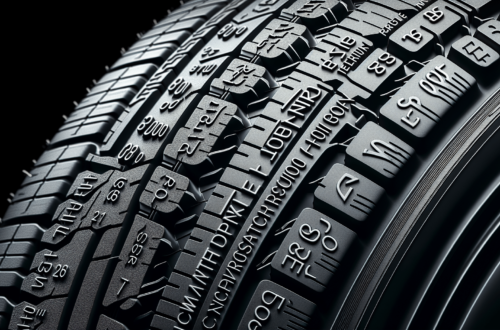Identifying Tire Safety Information
Do you know how to read the sidewall of your tires to ensure they are safe for the road? Understanding the various markings and codes on your tire sidewall can provide you with valuable information about your tires’ safety and performance. Let’s break down how to decode this essential information for your peace of mind while driving.
Deciphering the DOT Code
The Department of Transportation (DOT) code is a crucial part of the tire sidewall that provides information about the tire’s manufacturing date, size, and other relevant details. Look for the DOT code on the sidewall, which typically starts with the letters “DOT” followed by a series of numbers and letters.
The DOT code is usually located on one side of the tire near the bead area. It is essential to identify and understand this code to determine the age of your tires and track their history for safety purposes.
Understanding the Manufacturing Date
The last four digits of the DOT code represent the manufacturing date of the tire. The first two digits indicate the week, while the last two digits signify the year. For example, if the DOT code ends with “3019,” it means the tire was manufactured in the 30th week of 2019.
It is crucial to check the manufacturing date of your tires to ensure they are not too old or past their expiration date. Older tires can pose safety risks due to wear and tear, so make it a habit to inspect the manufacturing date periodically.

This image is property of images.unsplash.com.
Recognizing Tire Size and Type
The tire sidewall also contains information about the tire size, load index, and speed rating, which are essential for ensuring your tires are suitable for your vehicle. The tire size is usually denoted by a combination of numbers and letters, such as “P215/60R16.”
The letter “P” indicates the tire’s type (passenger), followed by the tire width in millimeters (215) and the aspect ratio (60), which represents the percentage of the sidewall’s height to the tire’s width. The “R” indicates the tire’s construction type (radial), while the number after it denotes the wheel diameter in inches (16).
Understanding the tire size and type is crucial for selecting the right tires for your vehicle and ensuring optimal performance and safety on the road.
Checking the Load Index and Speed Rating
The load index and speed rating are two important aspects of tire safety that are also indicated on the sidewall. The load index represents the maximum weight a tire can support, while the speed rating indicates the maximum speed the tire can handle safely.
The load index is typically a two or three-digit number located after the tire size, such as “94” or “XL.” Refer to a load index chart to determine the maximum weight capacity of your tires based on the index number.
The speed rating is denoted by a letter following the load index, such as “H” or “V.” Each letter corresponds to a specific speed range, so it is essential to choose tires with an appropriate speed rating for your driving habits and vehicle specifications.

This image is property of images.unsplash.com.
Inspecting Tread Wear Indicators
Tread wear indicators are small rubber bars built into the tire’s tread grooves that help you monitor the level of wear on your tires. These indicators become visible as the tread wears down, indicating that it is time to replace the tire for safety reasons.
Check the tread wear indicators regularly by inspecting the tread depth and looking for the small rubber bars between the treads. If the indicators are flush with the tread, it is a sign that the tire has reached the minimum tread depth and needs to be replaced.
Understanding Tire Pressure Recommendations
Proper tire pressure is essential for optimal performance, fuel efficiency, and safety on the road. The tire sidewall provides information about the recommended tire pressure, typically indicated in PSI (pounds per square inch).
The recommended tire pressure can vary based on the tire size, vehicle weight, and driving conditions. Check your vehicle owner’s manual or the sticker inside the driver’s door jamb for the manufacturer’s recommended tire pressure values.
Maintain the correct tire pressure by regularly checking and adjusting it as needed to ensure your tires’ longevity and safety while driving.

This image is property of images.unsplash.com.
Identifying Traction and Temperature Ratings
Traction and temperature ratings are additional indicators of tire safety and performance that can be found on the sidewall. The traction rating represents the tire’s ability to stop on wet surfaces, while the temperature rating indicates the tire’s resistance to heat buildup.
The traction rating is denoted by letters “AA,” “A,” “B,” or “C,” with “AA” being the highest rating for superior wet traction. The temperature rating consists of letters “A,” “B,” or “C,” with “A” representing the highest resistance to heat.
Understanding these ratings can help you choose tires that provide excellent handling and safety in various road conditions, ensuring a smooth and secure driving experience.
Checking for Uniformity and Balance
Inspecting your tire sidewall for signs of uniformity and balance is crucial for maintaining optimal tire performance and safety. Look for any irregular wear patterns, bulges, or abnormalities on the sidewall that could indicate an issue with tire balance or alignment.
Uneven wear can be caused by incorrect tire pressure, misalignment, or suspension problems, leading to reduced traction and handling. Address any issues promptly to prevent further damage to your tires and ensure a smooth and safe driving experience.
Monitoring Tire Rotation and Maintenance
Regular tire rotation and maintenance are key factors in extending the lifespan of your tires and ensuring their safety and performance. Rotate your tires according to the manufacturer’s recommendations, typically every 5,000 to 7,000 miles, to promote even tread wear and maximize tire longevity.
In addition to rotation, maintain proper tire inflation, alignment, and balance to prevent premature wear and potential safety hazards. Conduct routine tire inspections and address any abnormalities promptly to keep your tires in optimal condition for a safe and comfortable driving experience.
Conclusion
Reading your tire sidewall for safety information is an essential skill that can help you maintain your tires and ensure a secure driving experience. By understanding the various markings, codes, and ratings on the sidewall, you can make informed decisions about tire selection, maintenance, and replacement to enhance safety and performance on the road.
Remember to check the DOT code for manufacturing dates, inspect tire size and type, and pay attention to load index, speed rating, tread wear indicators, and pressure recommendations for optimal tire safety. By following these guidelines and staying proactive with tire maintenance, you can enjoy peace of mind knowing your tires are in top condition for all your journeys.





